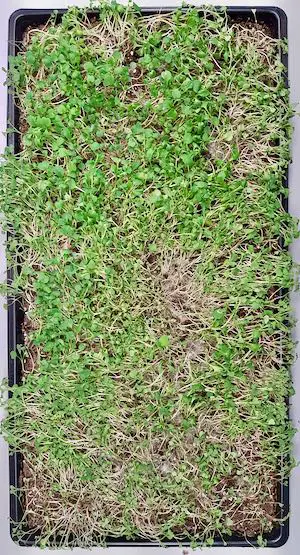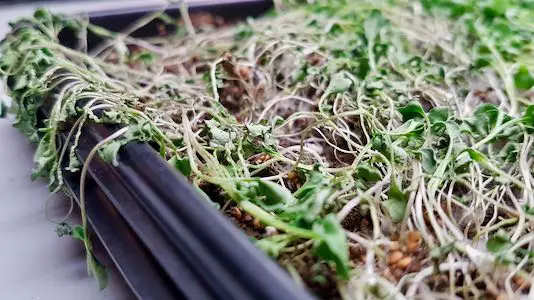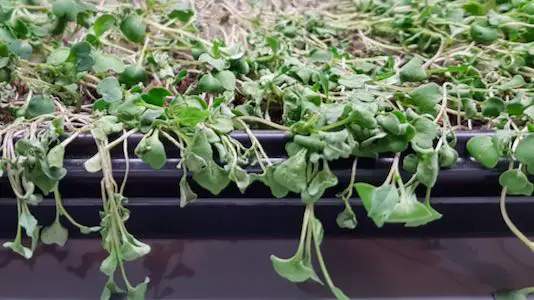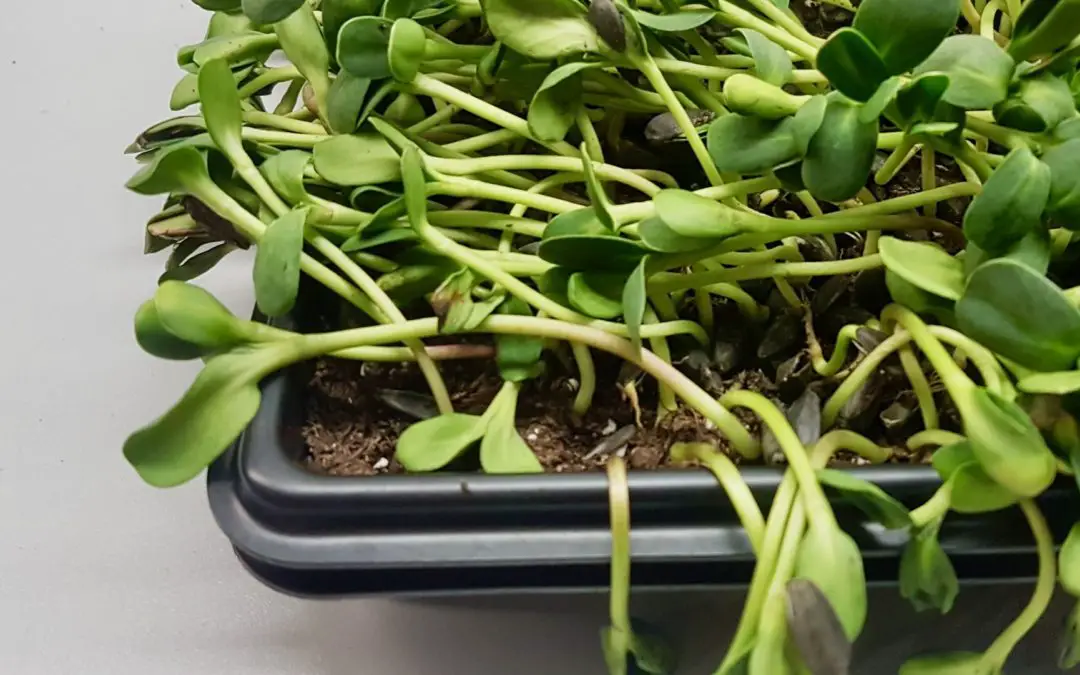Microgreens can wilt and fall over from a number of causes, but there is some logical troubleshooting you can do to get to the bottom of it.
Reasons why microgreens wilt and fall over
- 1. Underwatering
- 2. Harvesting Late (Tall/stretching)
- 3. Growing in the Hot Sun
- 4. Thin-Stemmed Microgreens
- 5. Top-watering with too Much Pressure
- 6. Lack of Ventilation
- 7. Intense Lighting
- 8. Insufficient Light
- 9. Unsanitary Equipment and Supplies
- 10. Disease Pressure
- 11. Damping-Off
- 12. Low Quality Seeds
Learn from my mistakes and arm yourself with knowledge from this article and you’ll save a lot of time and money.
And some microgreens are just plain hard-to-grow (like the ones I walk through in this this article about difficult-to-grow microgreens).
 1. Underwatering
1. Underwatering
By far, the largest cause microgreens wilting and falling over is under-watering. Not enough water.
Underwatering usually causes the microgreens to wilt & fall over in a corner, or around the edges of your growing container first. These are the first parts to dry out, with the center holding the most moisture. Feel the soil with your finger.
If it’s dry, time to add a little water. And if you catch it soon enough, your microgreens might recover.
To fix this, just give your microgreens some water. I like to add about ½ quart (500 mL) of water to a 10” x 20” tray when a tray wilts and I suspect they don’t have enough water.
2. Harvesting Late
Harvesting late gives the microgreens more time to grow, and they become heavier and are more likely to fall over.
Whatgrass in particular commonly falls over when grown too long. While it’s not technically a microgreen, it’s a great example of what can happen if you grow longer.
Depending on the soil you’re using, harvesting late (more than a couple days) also can have an impact on flavor and color (in addition to falling over).
Some microgreens become yellower as they mature (wheatgrass can be an example), while others become a much deeper green and grow true leaves (sunflower). In both of these cases the taste deteriorates and the texture become more fibrous and less pleasant.
The solution?
Harvest on time!
3. Growing in the hot sun
The second biggest cause of microgreens falling over and wilting is heat.
If you’re growing microgreens outside, or in a greenhouse, heat can be a real killer for your microgreens, even if you’re watering your heart out!
Microgreens that aren’t acclimatized to the sun because you just moved them outside are particularly at risk of wilting in the sun.
It’s best to give partial shade to microgreens outside, or grow them in a greenhouse where the humidity is higher so evaporation won’t be as extreme.
4. Thin-Stemmed Microgreens
Some microgreens are notoriously hard to grow, and often it’s because they have really thin stems, like amaranth and chives. These delicate microgreens can’t tolerate dramatic changes in conditions.
If watering is a day late, or the sun’s a little too bright, these microgreens can quickly wilt and fall over. Their thin stems just don’t hold enough moisture to cope with changes.

5. Top-Watering with Too Much Pressure
Ideally you want to sub-irrigate (water between a perforated and solid tray). But if you must water from the top, think of a gentle shower. That’s the goal!
Don’t blast your microgreens with high pressure directly from the house.
If you’re growing small amounts at home you can use a thin-stemmed watering can to water between trays (sub-irrigation). Or get a watering can with a wide head for gentle top-down watering.
For higher volume microgreen growing, get a watering wand with “gentle” or “rain” in the name. This will help keep your microgreen seeds in one place.
6. Lack of Ventilation
Not enough air movement can cause big problems for microgreens. Ventilation is often necessary, particularly at lower elevations where high humidity is likely to be a bigger problem.
It can be a problem in greenhouses too. Greenhouses often have really high humidity, and it’s challenging to keep it low, especially if you’re growing a lot. Moving the humid air around definitely helps, so installing extra fans is a good option to keep in your back pocket.
Air movement is important for the roots too. We don’t often think about it, but roots don’t just absorb water and nutrients, they need access to air too. You can drown a plant if the roots don’t have ventilation.
This can be a problem when growing microgreens in a glass container, like a jar or glass bakeware. I walk through a zero waste approach to growing microgreens in this article about growing microgreens in glass.
7. Intense lighting
Intense light can damage microgreens, dry them out, and cause them to wilt, especially if the change is sudden.
Going from a blackout period to full sunlight is a sure recipe for disaster.
If a light source is too close to microgreens it can cause problems too. I like to keep cooler light sources like fluorescent tubes or LEDs at least 8” away, preferably 12”.
You’ll want even more spacing (or appropriate cooling) for the older, hotter light sources like High Pressure Sodium (HPS) or Metal Halide (MH).
To fix problems related to intense light: move the microgreens into a more moderate lighting, consider raising lights. Outdoors consider using shade netting for partial shade. Full sunlight is often too much.
8. Insufficient light
Microgreens are living, growing plants. They need the right spectrums of light to properly photosynthesize and thrive (unlike sprouts).
If it’s a little foggy, you can clear up the terminology around sprouts vs microgreens in this article I wrote about exactly that.
Incandescent lights aren’t suitable for growing microgreens. While it can be done, your microgreens won’t be as robust and rich in nutrients. The microgreens will be thinner and more likely to wilt and fall over.
LED costs have come way down, and most windows have enough light for microgreens, so you have a few options. Just watch out for cold temperatures near windows if you’re in a colder climate.
9. Unsanitary Equipment and Supplies
If your tools aren’t squeaky-clean when you start working on your microgreens you could be in for some problems!
It might start off innocent enough. You just dug up some weeds in the garden, might as well measure out some soil and seed some micro-green trays while your hands are still dirty right?
Outdoors any one micro-organism is in a constant balance with everything else. But things change when you move indoors. If you bring in a big population of microorganisms: bacteria, fungi, spores, or other critters in a chunk of soil, it can run rampant without the natural competition it faces outside.
This can lead to a number of problems and in some cases cause mold and wilting.
Try to keep your microgreens supplies and equipment as clean and isolated as possible, especially if you’re growing indoors.
10. Disease Pressure
Disease pressure in microgreens usually comes from conditions related to a lot of things mentioned above: water-logged soil, low ventilation, intense or insufficient light, and low quality seeds.
Low seed viability and vigor can increase disease pressure too. Seeds that don’t germinate, or germinate much slower than most can harbor fungi and other pathogens.
The moisture from the growing medium gives microorganisms a good chance at penetrating the defences of the dead or weakened seeds.
Once disease growth is underway, it’s best to cut your losses. Either cut that section out of the tray, or abandon the whole tray to compost.
Damping-off is a form of disease pressure, read-on to find out how it can completely ruin your microgreens.

11. Damping off
Damping-off is usually first visible as a thinning and darkening of the stems. Usually you first see it right where the stems are emerging from the soil.
Eventually you might notice water-logged, translucent leaves, and the greens will shrivel and wilt.
Damping off is a tricky one. It’s thought to be caused by micro-organisms present on your tools, in the soil, on the seeds, or blowing in on the wind.
Damping-off microorganisms include:
- Pythium
- Fusarium
- Rhizoctonia
And because of these little monsters (and others), when you’re growing microgreens you’re in race.
You want to set up optimal conditions for growing your microgreens, and prevent ideal conditions for microorganisms if at all possible. It’s also a good idea to avoid water-logging the soil, and cleaning your tools and equipment frequently.
If you continually have problems with damping off, eliminate the potential causes one by one:
- Tools: Sterilize your tools and growing trays to the best of your ability
- Soil: try a soilless mix, or source the most sanitary soil you can
- Environment: grow inside instead of in your greenhouse
- Seeds: maybe your batch was contaminated, try a new variety
- Water: It’s unlikely, but your water source could be the problem. If you’re using rain barrels, well water, or otherwise untreated water, try switching as an experiment.
12. Low quality seed
If seed isn’t handled and stored properly (find a wealth of information on that topic in my article here), the viability and vigor drops. This can cause a lot of problems when you’re growing your microgreens.
And remember, you don’t need special seed for microgreens, just high-quality seed. I wrote an article about this, in it I also cover:
- What to look for when selecting microgreen seeds.
- Can you use bird-seed to grow microgreens (it’s way cheaper)
Conclusion
Thanks for reading this far!
The best way to solve most of these problems is to arm yourself with information:
Familiarize yourself with the key steps of growing microgreens. (Links to Article)
Learn how to store microgreen seeds for long shelf life & vigorous growth. (Links to Article)
Avoid the hardest-to grow microgreens, or master the secrets to success. (Links to Article)

I’m Alex Lafreniere. I learned a lot about plants when I built and operated a landscaping company. But, there’s always more to learn. Ever since travelling across the world, I’ve wanted to find ways to bring more tropical and exotic plants into my life. This is the site where I share everything I’ve learned with you.
This site is owned and operated by Plant Hardware, a sole proprietor headquartered in Calgary, Canada. Plant Hardware is a participant in the Amazon Services LLC Associates Program, an affiliate advertising program designed to provide a means for sites to earn advertising fees by advertising and linking to Amazon.com.Plant Hardware may also participate in affiliate programs with Bluehost, Clickbank, CJ, ShareASale, and other sites. Plant Hardware is compensated for referring traffic and business to these companies.

